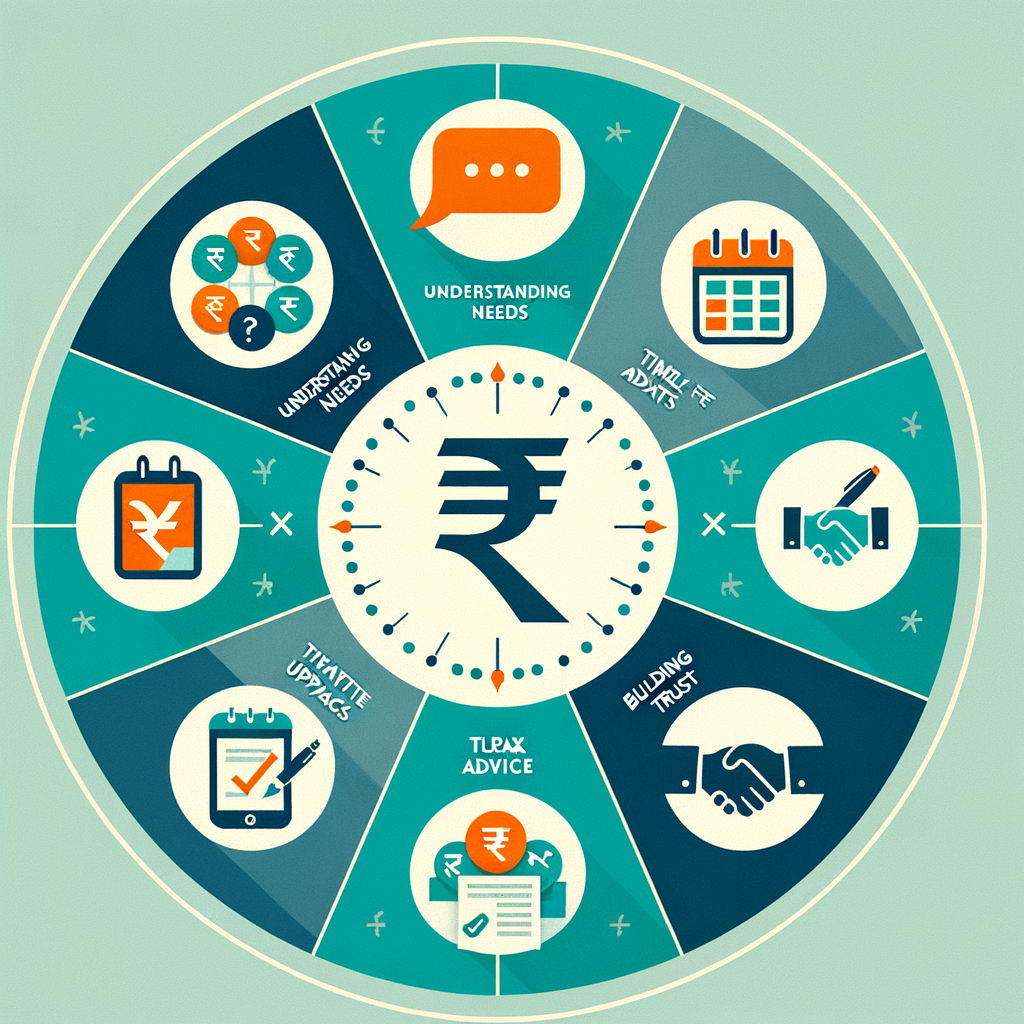Best Practices for Mastering Client Communication in Tax Advisory
Tax compliance in India can be complex. What makes it even more stressful is a communication gap with your tax advisor. This gap can lead to missed deadlines, incorrect filings, and a breakdown of trust. The foundation of a successful relationship between a client and a tax professional is built on strong client communication in tax advisory. It’s not just about exchanging information; it’s about building a partnership based on clarity, accuracy, and mutual understanding. This guide provides actionable and effective client communication strategies India for both tax professionals aiming to elevate their services and for clients—small business owners and salaried individuals—to understand what to expect from a truly great advisor. Mastering these practices ensures that compliance becomes a smooth, transparent process rather than a source of anxiety.
The Foundation: Setting the Stage for Clear Tax Advisory Communication
Onboarding: Setting Clear Expectations from Day One
The initial phase of any client relationship is the most critical for setting the tone for all future interactions. A thorough onboarding process eliminates ambiguity and builds immediate confidence. During the first consultation, it’s essential to go beyond a simple introduction and meticulously define the scope of the engagement. This means clearly outlining which services are included—such as GST return filing, TDS compliance, or annual Income Tax Return (ITR) preparation—and, just as importantly, which are not. You must establish firm timelines for filings, specifying due dates and the deadlines for clients to submit necessary documents. A transparent fee structure, detailing costs for agreed-upon services and the rates for any potential additional work, prevents future disputes. One of the best tax advisory communication tips India is to create a comprehensive “Client Welcome Kit.” This digital or physical package should be a go-to resource for the client, containing the engagement letter, a summary of services, key filing dates, the fee schedule, and a clear guide on preferred communication channels. For instance, specify that all official documents should be shared via a secure portal or email, while quick, non-sensitive queries can be handled via WhatsApp Business, and detailed discussions will be scheduled via a formal call.
Understanding Your Client: Tailoring Communication for Different Needs
Effective communication is never one-size-fits-all. The tax communication strategies Indian clients require must be carefully tailored to their specific financial context and level of knowledge. A small business owner has vastly different concerns than a salaried professional, and your communication style must reflect this. These distinct approaches are central to effective client communication techniques tax advisory.
- For Small Business Owners: Your communication should be business-centric, focusing on compliance and its impact on their operations. Instead of just mentioning GST, break it down into its practical components—CGST, SGST, and IGST—and explain how they apply to the client’s specific transactions. A crucial topic is the Input Tax Credit (ITC), where you must clearly explain how it works and what documentation is needed to claim it successfully. Similarly, discuss TDS compliance on payments they make, such as rent or professional fees, and provide practical advice on managing cash flow to ensure funds are available for Understanding and Managing Advance Tax Payments.
- For Salaried Individuals: The focus here shifts to personal finance optimization. Your primary role is to help them understand their payslip and Form 16. Clearly explain the various deductions available under Chapter VI-A, using simple language to describe popular sections like 80C (for investments like EPF, PPF), 80D (for health insurance), and 80G (for donations). If the client has investments, you must simplify the concept of capital gains from stocks, mutual funds, or property. One of the most important discussions today is guiding them through the old vs. new tax regime, presenting a clear calculation to help them choose the most beneficial option for their financial situation. A key resource for this is our guide on Old vs New Tax Regime: Which Is Better New Tax Regime Or Old Tax Regime For Salaried Employees?.
Proactive Strategies: Key to Improving Client Communication in Tax Advisory Firms
Demystifying Jargon: Translating ‘Tax-Speak’ into Simple Language
The world of taxation is filled with acronyms and technical terms that are second nature to professionals but completely alien to the average client. Using this jargon without explanation can make clients feel uninformed and hesitant to ask questions. A core principle of exceptional client service is to translate complex “tax-speak” into simple, relatable language. This practice builds trust and empowers clients by helping them understand their own financial obligations. For example, instead of asking a client to verify their “ITR-V,” you should describe it as “the one-page document you receive after filing your return, which needs to be e-verified to complete the process.” Likewise, “Form 26AS” can be explained as “your annual tax statement, which is like a tax passbook showing all taxes deposited against your PAN.” A highly effective and actionable tip is to create a simple, one-page glossary of common tax terms (like ‘Assessee’, ‘Assessment Year’, ‘TDS’, ‘Advance Tax’) and share it with every new client. This small gesture demonstrates a commitment to clarity and can significantly improve the quality of your interactions.
Regular & Meaningful Updates
Silence is often interpreted as a lack of progress, which can cause significant anxiety for clients, especially during critical tax seasons. Proactive and regular communication is a hallmark of professional service and is fundamental to improving client communication tax advisory firms. It’s not about overwhelming the client with information but about providing timely and relevant updates that offer peace of mind. Even a brief email stating, “We have received your documents and everything is on track for the upcoming GST filing. No further action is needed from you at this time,” can prevent a worried phone call. Establishing a regular communication rhythm is key. A highly recommended practice is to send a monthly or quarterly newsletter. This newsletter can serve multiple purposes: it can provide general updates on recent due date extensions announced by the government, explain minor policy changes that might affect a broad client base, or offer timely tax-saving reminders, such as making investments before the end of a quarter. This proactive approach positions you as a knowledgeable and caring advisor, not just a service provider.
Leveraging Technology for Seamless Communication
In today’s digital age, leveraging technology is no longer optional—it’s essential for efficient, secure, and organized client communication. Adopting the right tools can streamline processes, save time for both you and your client, and create a professional and modern client experience. The best client communication methods for tax advisors often involve a suite of carefully chosen digital solutions.
- Secure Client Portals: These are invaluable for sharing sensitive financial documents. They offer a much higher level of security than email and create a centralized repository for all important files, accessible to both you and the client 24/7.
- Email: This remains the best tool for formal communication, creating a written record of important discussions, decisions, and approvals. It is the professional standard for sending engagement letters, final reports, and tax computation summaries.
- WhatsApp Business: For quick, non-sensitive queries and reminders, WhatsApp Business is incredibly effective. It’s perfect for sending a quick nudge about a pending document or answering a simple, non-confidential question, offering an immediacy that email lacks.
- Scheduling Tools (like Calendly): Eliminate the frustrating back-and-forth of scheduling meetings by using an automated tool. This allows clients to see your availability and book a consultation slot that works for them directly from your website or email signature.
When explaining official processes, always direct clients to official sources to build their trust and knowledge. Refer them to the Income Tax Department portal for information on ITR filing and Form 26AS, and the GST Portal for GST-related rules and updates.
Handling Difficult Conversations with Empathy and Clarity
Delivering Unfavorable News (e.g., Higher Tax Liability, Notice from ITD)
Delivering bad news is one of the most challenging aspects of tax advisory. Whether it’s an unexpected tax liability, a disallowance of a claimed expense, or a notice from the Income Tax Department, the manner in which you communicate this information can define the future of your client relationship. Handling these situations with professionalism and empathy is a cornerstone of excellent client communication tax advisory practices India. Rushing the conversation or being dismissive can shatter trust. Instead, follow a structured and compassionate framework:
- Schedule a Call: Never deliver significant unfavorable news via a brief email or text message. A scheduled phone or video call shows respect for the client and the seriousness of the matter.
- Be Direct & Empathetic: Start the conversation by stating the issue clearly and concisely, but immediately follow up with an empathetic tone. For example, “I’m calling to discuss your tax calculation, and unfortunately, the liability is higher than we initially estimated. I know this isn’t the news you were hoping for.”
- Explain the “Why”: After stating the problem, methodically break down the reasons behind it. Use simple language to explain the specific tax law, calculation error, or reason for the scrutiny notice. Transparency is crucial here; the client must understand that the outcome is based on rules and facts, not an error on your part (unless it is, in which case honesty is paramount).
- Present an Action Plan: This is the most important step. Immediately shift the focus from the problem to the solution. Outline the precise next steps, whether it’s gathering more documents, preparing a response to the notice, or planning for the payment. This proactive approach reassures the client that you are in control and have a clear path forward. For detailed instructions on this, our Responding to Income Tax Notices: A Step-by-Step Guide is an invaluable resource.
Managing Scope Creep and Discussing Additional Fees
“Scope creep”—when a client’s requests gradually expand beyond the services outlined in the original agreement—is a common challenge in any service industry. Handling it poorly can lead to resentment from both sides. The client may feel they are being unfairly charged, while the advisor may feel they are working for free. The key to managing this is to lean on the clarity established during the onboarding process. When a client requests work that falls outside the initial scope, such as assistance with a personal loan application or detailed cash flow forecasting, politely and professionally refer back to the “Client Welcome Kit” or the engagement letter. You can say something like, “I’d be happy to help with that. This falls outside our current scope for GST filing, but I can prepare a separate proposal for this additional work.” It is crucial to provide a clear, transparent quote for the new task and get the client’s approval before commencing any work. This approach respects the client’s needs while also respecting the value of your time and expertise, maintaining a professional and fair relationship.
Conclusion: Great Tax Advisory is Built on Great Communication
Ultimately, the technical expertise of a tax advisor is only as effective as their ability to communicate it. The pillars of excellent client communication in tax advisory rest on a foundation of setting clear expectations from day one, speaking the client’s language by demystifying jargon, being proactive with updates, and handling difficult conversations with professional empathy. By embracing these practices, tax professionals can transform their client relationships from transactional to collaborative. Adopting these best practices client communication tax India doesn’t just reduce errors and misunderstandings; it builds lasting trust, leads to higher client retention, and solidifies a reputation for excellence in a competitive market. For clients, understanding these principles helps you identify a truly valuable financial partner.
Looking for a tax partner who values clear and proactive communication? Contact TaxRobo today for expert financial and legal services tailored to your needs.
Frequently Asked Questions (FAQs)
1. How often should I communicate with my tax advisor?
The ideal communication frequency depends entirely on your specific needs and the complexity of your financial situation. For small business owners dealing with monthly compliance like GST and TDS, regular monthly check-ins are good practice to ensure everything is on track. For salaried individuals, communication might be less frequent but should occur at key points during the year: once at the beginning of the financial year for tax planning, again mid-year for proof submission to employers, and finally during the tax filing season. The most important thing is to have an agreed-upon communication plan with your advisor from the very beginning.
2. What’s the best way to explain a complex tax change, like a new GST rule, to a client?
The best approach is to use the “What, So What, Now What” method. This framework breaks down complex information into digestible and actionable parts.
- What: Start by stating the new rule in the simplest terms possible, avoiding technical jargon. (e.g., “The government has changed the GST rate on this specific service from 12% to 18%.”)
- So What: Immediately explain how this change directly impacts the client’s business or finances. (e.g., “This means that from next month, you will need to charge your customers the new 18% rate, and your invoices will need to be updated.”)
- Now What: Conclude by providing clear, actionable steps the client needs to take. (e.g., “We need you to update the pricing in your invoicing software. I have sent you an email with the exact steps to follow.”)
3. What documents should I have ready before a meeting with my tax advisor?
Being prepared for a meeting makes the communication far more efficient and productive. For an initial consultation, you should generally have your PAN card, Aadhaar card, and any relevant business registration documents (like a GST certificate or partnership deed). For an annual tax filing meeting, the list is more extensive: have all your bank account statements for the financial year, Form 16 (from your employer) or Form 16A (for other TDS), proofs of investments for deductions (like ELSS, PPF, insurance receipts), details of any property or stock sales, and a summary of your income and major expenses.
4. How can technology improve communication with my tax firm?
Technology is a critical enabler of modern and effective client communication tax advisory. Secure client portals are essential for safely sharing confidential documents like bank statements and ITRs, ensuring your data is protected from cyber threats. Email provides a formal, written record of all important communication, which is crucial for accountability. Scheduling apps like Calendly eliminate the hassle of booking appointments, saving time for both you and your advisor. Finally, using tools like WhatsApp Business for quick reminders or simple questions provides an instant and convenient channel for communication. This tech stack helps keep information organised, secure, and easily accessible, leading to a smoother and more professional client experience.



